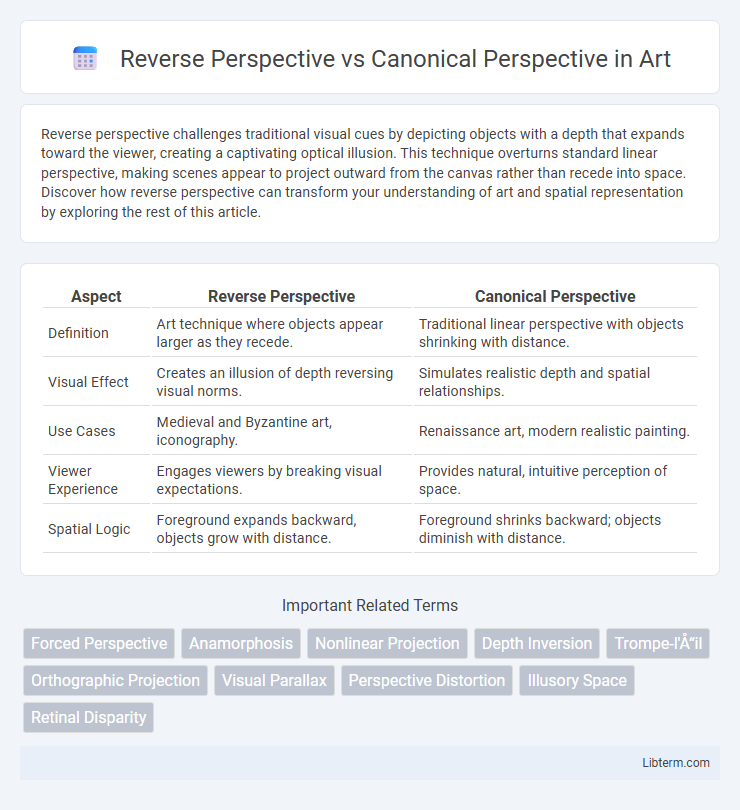Reverse perspective challenges traditional visual cues by depicting objects with a depth that expands toward the viewer, creating a captivating optical illusion. This technique overturns standard linear perspective, making scenes appear to project outward from the canvas rather than recede into space. Discover how reverse perspective can transform your understanding of art and spatial representation by exploring the rest of this article.
Table of Comparison
| Aspect | Reverse Perspective | Canonical Perspective |
|---|---|---|
| Definition | Art technique where objects appear larger as they recede. | Traditional linear perspective with objects shrinking with distance. |
| Visual Effect | Creates an illusion of depth reversing visual norms. | Simulates realistic depth and spatial relationships. |
| Use Cases | Medieval and Byzantine art, iconography. | Renaissance art, modern realistic painting. |
| Viewer Experience | Engages viewers by breaking visual expectations. | Provides natural, intuitive perception of space. |
| Spatial Logic | Foreground expands backward, objects grow with distance. | Foreground shrinks backward; objects diminish with distance. |
Introduction to Reverse and Canonical Perspectives
Reverse perspective challenges traditional visual representation by depicting objects with contours that expand toward the viewer, creating an illusion of depth opposite to canonical perspective. Canonical perspective, rooted in Renaissance art, employs converging lines and vanishing points to mimic human eye perception, establishing realistic depth on a flat surface. Understanding these contrasting techniques highlights how spatial perception can be manipulated to evoke different visual experiences.
Defining Reverse Perspective
Reverse Perspective defies traditional Canonical Perspective by projecting objects to appear larger as they recede into space, creating an illusion that challenges standard visual depth cues. This technique manipulates spatial perception, making foreground elements smaller while background elements expand toward the viewer. Artists use Reverse Perspective to evoke dynamic, almost interactive experiences that contrast with the fixed viewpoint of Canonical Perspective.
Understanding Canonical Perspective
Canonical perspective is the traditional method of depicting three-dimensional objects on a two-dimensional surface, where parallel lines converge at vanishing points to create depth and realistic spatial relationships. This approach aligns with human visual perception and is widely used in art, architecture, and design to represent scenes as they appear in reality. Understanding canonical perspective enables accurate construction and interpretation of spatial dimensions, enhancing the realism and coherence of visual compositions.
Historical Origins of Both Perspectives
Reverse perspective traces its origins to Byzantine and Russian iconography, where artists employed it to create an immersive, spiritual experience by projecting the image outward toward the viewer. Canonical perspective, developed during the Italian Renaissance by pioneers like Brunelleschi and Alberti, established mathematical principles of linear perspective to represent three-dimensional space realistically on a two-dimensional plane. These historical backgrounds highlight reverse perspective's spiritual emphasis versus canonical perspective's scientific approach to visual representation.
Artistic Applications: Reverse vs Canonical
Reverse perspective challenges traditional depth cues by depicting objects as larger when farther away, creating a sense of spatial ambiguity in artwork. Canonical perspective applies linear techniques to simulate realistic depth, guiding viewers' focus through a vanishing point and converging lines. Artists employ reverse perspective to evoke mystical or surreal atmospheres, while canonical perspective remains dominant for achieving naturalistic representation and visual coherence.
Psychological Effects on Viewer Perception
Reverse perspective disrupts traditional spatial cues, causing viewers to engage with the artwork more actively as their brain reconciles conflicting depth signals, often evoking surprise or cognitive dissonance. Canonical perspective aligns with natural visual experience, promoting comfort and intuitive understanding by mimicking how the human eye perceives space and depth. This contrast influences psychological responses by either challenging perceptual expectations or reinforcing familiar spatial order, impacting emotional and cognitive engagement with visual content.
Use in Modern Visual Media
Reverse perspective distorts spatial relationships by expanding objects or scenes toward the viewer, commonly used in modern visual media to create immersive and surreal experiences. Canonical perspective employs linear perspective principles, accurately depicting spatial depth and proportion, essential for realistic rendering in films, video games, and graphic design. Contemporary artists and designers often blend reverse and canonical perspectives to evoke emotional responses and challenge viewers' perception of reality.
Cultural Significance and Symbolism
Reverse perspective challenges traditional spatial representation by portraying objects with converging lines extending toward the viewer, symbolizing an interactive relationship between the artwork and observer prominent in Byzantine and Eastern Orthodox iconography. This technique embodies spiritual transcendence, emphasizing the divine presence and the viewer's active engagement in the sacred space, contrasting with canonical perspective's realistic depth aimed at naturalistic representation developed during the Renaissance in Western art. The cultural significance of reverse perspective lies in its role in conveying metaphysical meaning and a timeless spiritual worldview, while canonical perspective reflects human-centered observation and empirical understanding of space.
Technical Challenges and Innovations
Reverse perspective challenges traditional visual representation by inverting spatial cues, creating an illusion where objects appear to extend outward toward the viewer, defying canonical perspective's convergence rules based on a single vanishing point. This innovation demands advanced computational algorithms and 3D modeling techniques to accurately render depth and spatial relationships without relying on conventional linear perspective. Addressing these technical challenges requires integrating perceptual psychology insights with graphics processing to achieve compelling, realistic visual effects in fields like virtual reality and immersive art installations.
Future Trends in Perspective Techniques
Future trends in perspective techniques emphasize the integration of reverse perspective with digital and augmented reality technologies to create immersive visual experiences that challenge traditional spatial perceptions. Advances in computational design enable dynamic manipulation of canonical perspective, allowing real-time adjustments that enhance user interaction in virtual and mixed reality environments. These innovations suggest a growing fusion of artistic and technological methods to evolve spatial representation beyond static, linear frameworks.
Reverse Perspective Infographic

 libterm.com
libterm.com